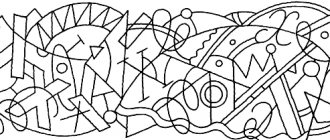Article:
General speech underdevelopment level 4 is the mildest form of the disorder.
Language components are almost normal; the child has a good vocabulary and coherent speech - this is enough for communication. However, at school he may still experience difficulties in learning to read and write. In order for a small schoolchild to study well, it is necessary to bring his speech skills to full compliance with the norm. In this article we will talk about level 4 OHP: characteristics and signs of a violation, who identified level 4 OHP and how to correct it.
General characteristics of OHP
If a child is already 5 years old, but he does not understand speech well and pronounces words in syllables, parents should pay attention to this case.
Sometimes phonetics pathology is observed in serious forms, such as stuttering, nasal speech, complete or partial loss of speech. Symptoms may indicate the presence of some disease. Only a specialized specialist can make a diagnosis. It is up to parents to seek help in a timely manner. Most often, speech pathology in a child occurs in a systemic manner, affecting different aspects of the development of the speech apparatus:
- lexico-grammatical;
- syllabic;
- intonation-melodic;
- sound;
- tempo-rhythmic;
- semantic.
If treatment is not started in time and left to chance, then the baby may later develop a partial impairment of the writing process.
Speech pathology in one form or another occurs in almost 35-40% of children. Speech disorder and its correction are determined by a number of factors. Serious consequences are caused by a brain abnormality that develops during intrauterine development. If there were unsuitable conditions for normal development during this entire time, then pathology of the entire brain region may develop.
Children with previously formed speech sometimes experience partial or total loss of speech. The children's brain tends to grow, so corrective classes started in time can restore speech functions.
The origin and development of the defect is diverse, but from a clinical point of view, special attention should be paid to a group of causes associated with disruption of the structure of the brain and central nervous system.
Diagnostics
To make a diagnosis, an examination by a pediatrician and a pediatric neurologist is required. Differentiation with other deviations in speech development is necessary: alalia, rhinolalia, autism, dysarthria, organic brain lesions and cerebral palsy.
A series of pictures to compose a story
During a comprehensive examination, the child is consulted by a speech therapist. Using special speech therapy methods, coherent speech during retelling, grammar, vocabulary, amplitude of movements of the articulatory apparatus, and features of sound pronunciation are assessed. They test the ability to identify and reproduce images. In conclusion, the teacher provides information about the type of OHP and its clinical symptoms.
Psychological and pedagogical characteristics of children with special needs development
Underdevelopment in the linguistic and speech structure significantly affects the development of sensory and intellectual capabilities. Experiments have shown that children with this pathology are noticeably behind their peers without deviations in terms of the level of organization of logical operations.
Children with SLD can be distinguished by their behavior and developmental delays in language learning:
- they try to make do with everyday conversational speech;
- emotionally selective towards games;
- are lagging behind in eloquent speech;
- speak poorly;
- have incomplete command of the morphemic structure of words and their form;
- have a small vocabulary.
The child plays little with peers, rarely asks questions, rarely initiates communication, and is inactive. In addition, there are problems with memorizing texts and developing fine motor skills.
The mental development of such children is ahead of their speech development. They are more critical of their shortcomings. As their defect is corrected, the intellectual process is leveled out.
Recommendations
The experience accumulated by speech therapists indicates that it is necessary to improve speech development; for this, children require motivation. Despite the fact that lexical and grammatical errors are unimportant, the child subsequently experiences difficulties with the learning process. Compared to his peers, he remembers new material less well and does not master grammatical rules. To get rid of isolation and shyness, the child is immersed in social situations through games. Their complexity increases gradually, individually for each patient.
OHP classification - 4 levels of violation
The typical state of children with pathology in speech and language development is divided into four levels. The severity of the disorder directly depends on the etiology of the disease.
Modern speech therapy divides the classification of defects into clinical and pedagogical directions. They actively complement each other. And most importantly, they have one goal: to determine a speech therapy report aimed at recruiting children’s groups with speech defects. This is necessary in order to implement a systemic differentiated effect on speech correction, taking into account the symptoms and mechanism of pathologies.
Clinical and pedagogical classification of OHP according to levels of impairment in the table:
| Violation level | Clinical manifestations | Psychological and pedagogical classification |
| ONR level 1 (absence of common speech). |
| Phonetic violations of the pronunciation of one sound or an entire group. |
| OHP level 2 (with rudiments of phrasal speech). |
| Phonetic-phonemic disorder of phonemic hearing and perception processes. |
| OHP level 3 (expanded phrasal speech with elements of lexico-grammatical and phonetic-phonemic pathology). |
| Systemic underdevelopment of speech with impairment of all components of the speech system. |
| OHP level 4 (individual difficulties and errors). |
| The communicative function of speech is disturbed. A combination of several levels is possible. |
Speech therapists, based on the clinical and pedagogical level, conduct diagnostics to identify a general speech disorder in a child and carry out timely correction.
Description
OHP level IV refers to a mild type of speech underdevelopment in preschoolers. The defect may go unnoticed if the child’s speech is not listened to by a professional speech therapist or teacher. The speech of a preschooler is understandable, but is characterized by an erratic pace, incoherence when composing stories, mixing a small number of sounds, and skipping syllables in complex words. But even such minor gaps in articulatory and communicative development can cause failure at school and difficulties in mastering the curriculum.
Causes of the disorder
Various reasons can lead to phonetic-phonemic brain damage. This can happen in the first years of the baby's life, during the placental period of development, or during childbirth.
Speech disorder can occur under the influence of various internal and external causes:
- neuroinfection;
- intoxication;
- birth injury;
- hereditary disorder of the central nervous system.
Speech is an important social function. For a child to grow fully, he needs communication with adults who are emotionally close to him. Unfavorable conditions in raising a child during the period of speech formation can lead to a delay in his development.
External factors influencing general speech underdevelopment:
- dysfunctional home conditions;
- lack of communication due to hearing and speech problems of relatives.
Disorders of oral speech and tempo can be caused by the following diseases:
- disorder of the vocal apparatus - dysphonia;
- frequent repetition or prolongation of sounds – stuttering;
- violation of sound pronunciation - dyslalia;
- nasality - rhinolalia;
- complete or partial loss of speech – aphasia;
- difficulty making disarticulated sounds - bradyllia;
- jerky stops for breathing - battarism;
- inability to master writing - dysgraphia;
- accelerated speech with hesitations, stumbling, and unnecessary pauses.
Often a combination of different reasons can be identified. Therefore, it is very important to establish the true factors to help the child cope with his problem. Severe violations require immediate treatment and special corrective work.
How is the diagnosis made?
Babies develop speech at different rates.
To establish a speech therapy conclusion, the child must accumulate a passive and active vocabulary, be able to compose coherent small sentences, and form the plural. It is by the age of 3 that the main components of speech begin to form. Therefore, the diagnosis begins to be made at this age. At the beginning of the school year, speech therapists conduct classes for children to identify speech disorders. Differential diagnosis is based on the general didactic principles of accessibility, perception, and gradual complication. Children are encouraged to draw, work on letter assignments, and solve conflicting problems. This could be writing a short essay about vivid impressions or finding a hidden letter in a picture.
To examine phonemic perception, the teacher asks the child to draw a word and find mistakes.
To test letter recognition, the baby is given printed and written versions of letters. He must either complete the missing part, or find differences, or convert the printed font into handwritten one.
The results may help select a group of children with whom speech therapists should work and with whom further in-depth examination will be required.
The main condition for diagnosing pathology is multicomponentity. Clinical diagnosis examines impairment of oral and written language.
A good exercise for correcting speech is “learn the letters”
The concept of abnormal manifestations of speech
General underdevelopment of speech (GSD) - it means a speech disorder when normally hearing children with preserved mental abilities have unacceptable and completely defective speech: from its sound to its meaning.
This concept was caused by a vital necessity and became firmly established in educational structures for children, in which speech therapy groups were formed. The term OHP was coined by the founder of Russian speech therapy, R. E. Levina (the levels of OHP according to Levina are given below).
Regardless of the origin of the defect, there are systemic complications of speech. Signs of a speech disorder:
- Speaking begins at approximately 3-5 years of age.
- Incorrect wording of words and phrases.
- Pronounced sounds are distorted.
- Incomprehensible conversation.
To distinguish between speech impairment, a speech therapist must conduct a thorough study of the disease of a particular child!
Useful and interesting facts
Ancient people spoke quite primitively, including vocal, visual and tactile functions. It was more like an exchange of information among animals. We learned to talk, when we started using symbols, we began to want to share this knowledge with our people. Scientists believe that the first symbol appeared when they began to make tools from stone. This was almost 2.5 million years ago. The activity played a leading role in the history of the development of human communication.
The first mention of speech defects associated with physical injury was in the ancient Egyptian papyrus of Edwin Smith. In religious epics, such as the Bible and the Koran, there are descriptions of miraculous healing of speech disorders. The priests gave a divine coloring to the fact of difficult speech.
Hippocrates was the first to write about the role of the brain in his writings, where he outlined his view of how the formation of human voice and speech occurs.
The speech correction process is quite lengthy and labor-intensive. The accumulated experience of specialized specialists shows that it is parents who need to pay special attention to the environment in which the baby lives. You also need to engage in speech development from a very early age.




